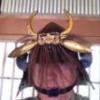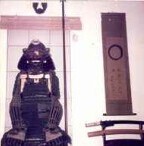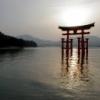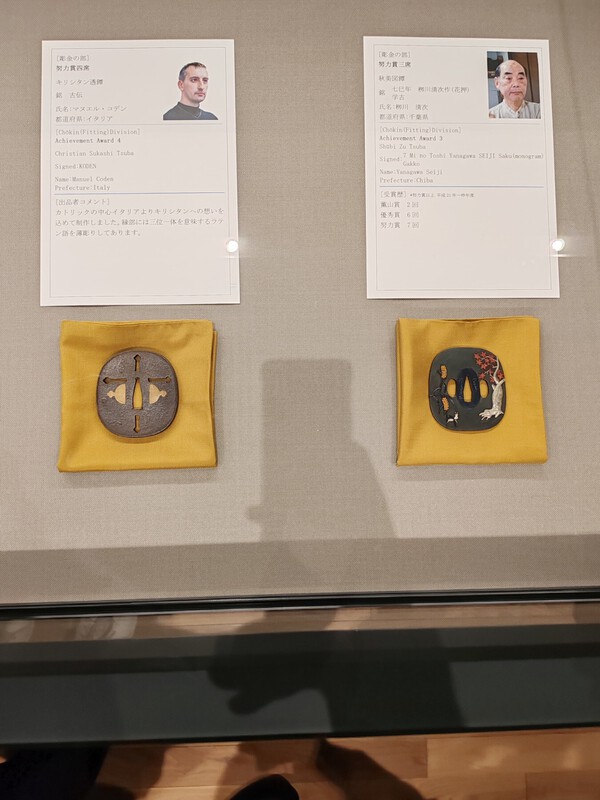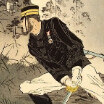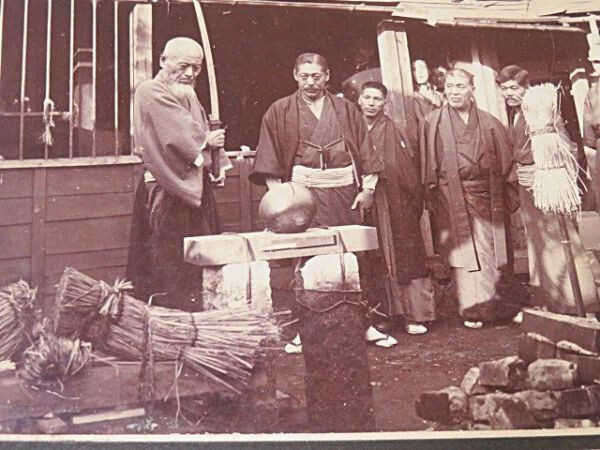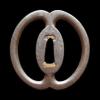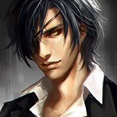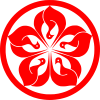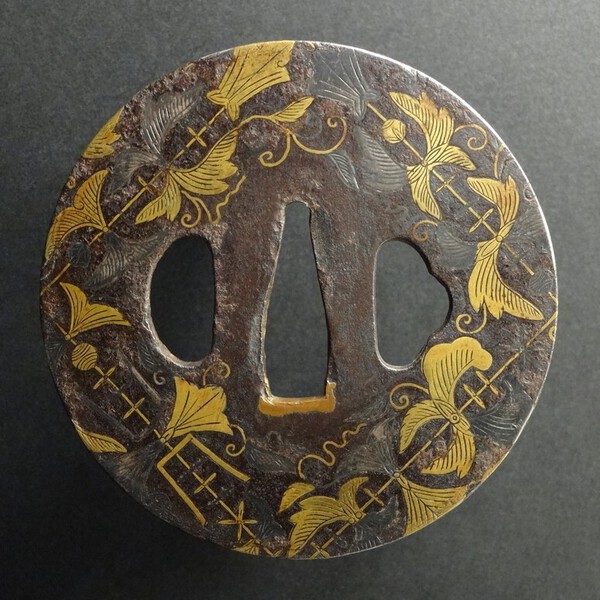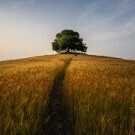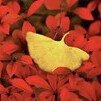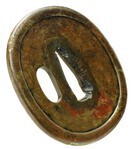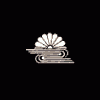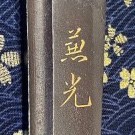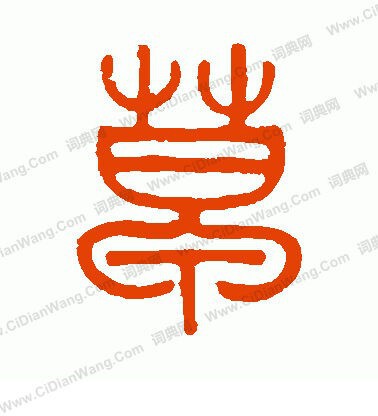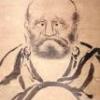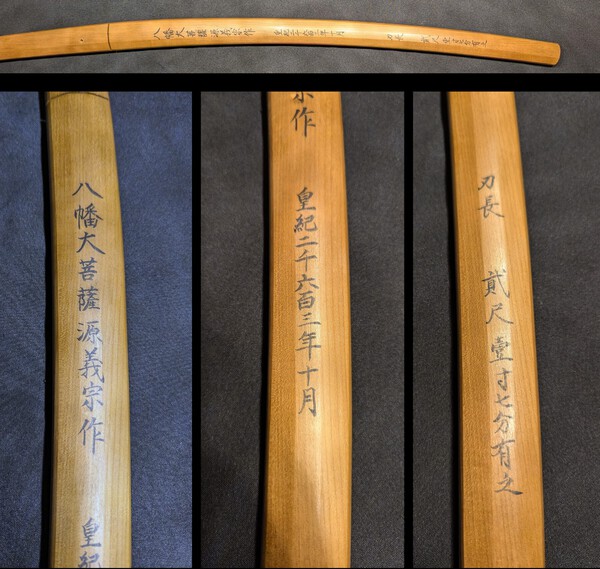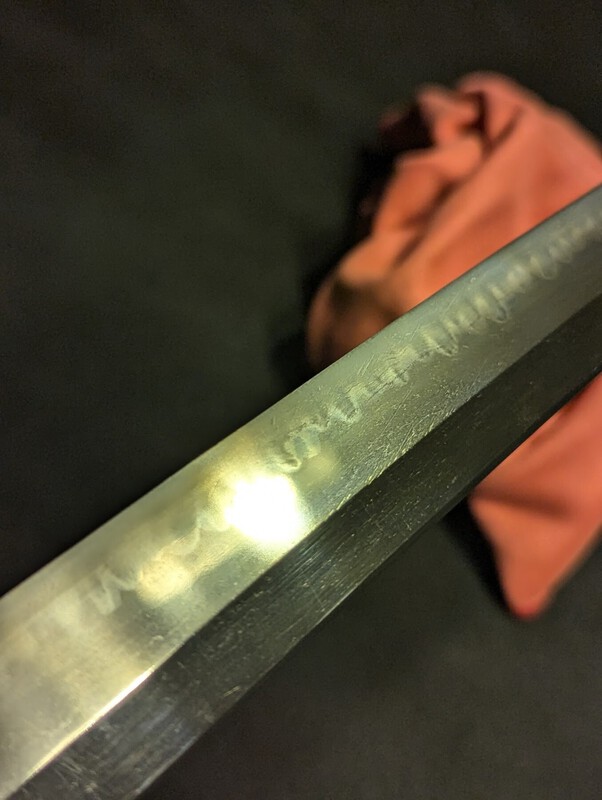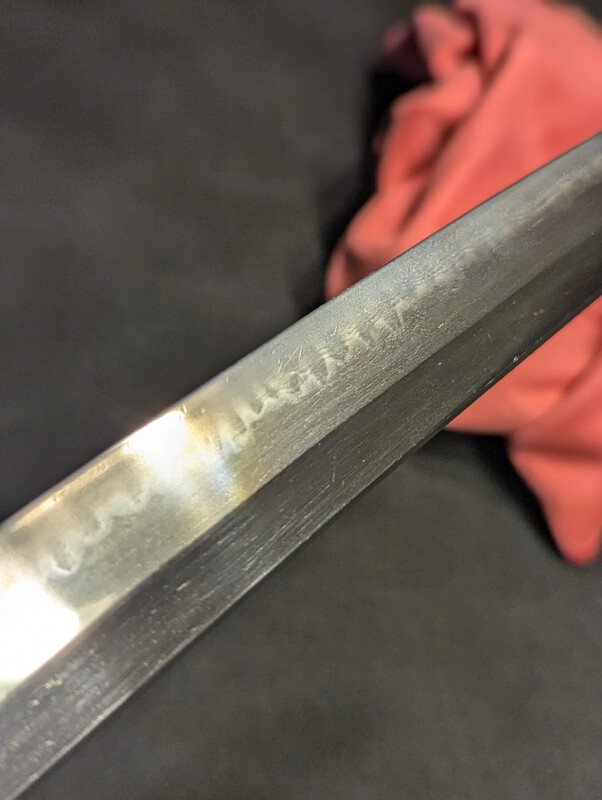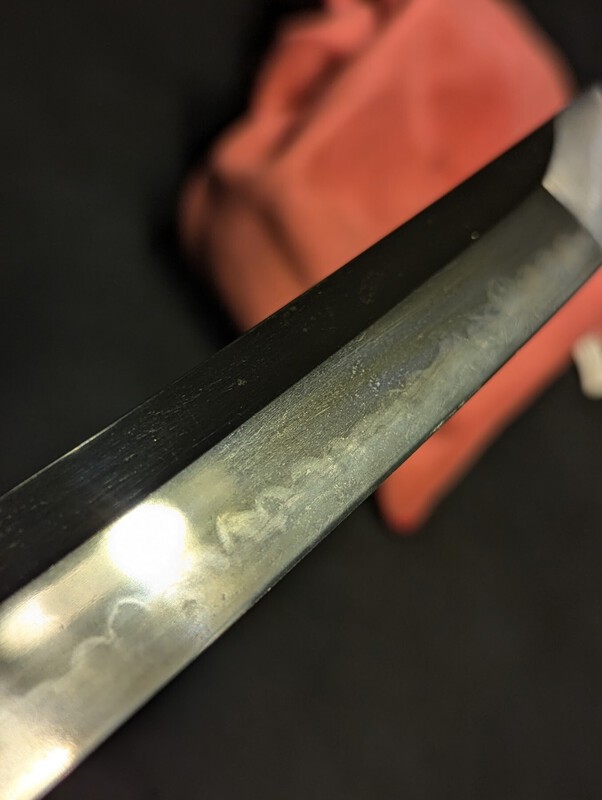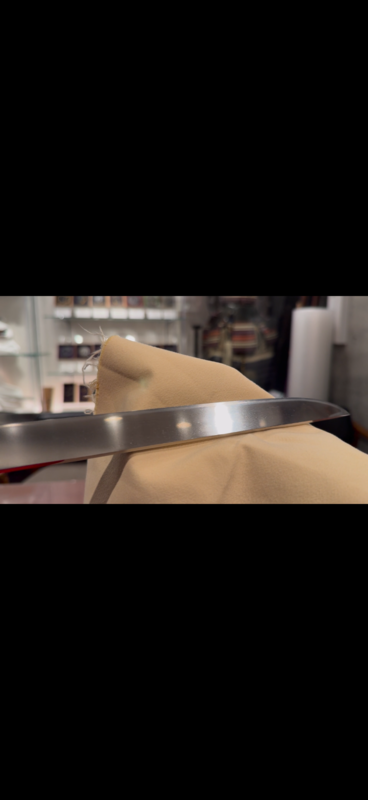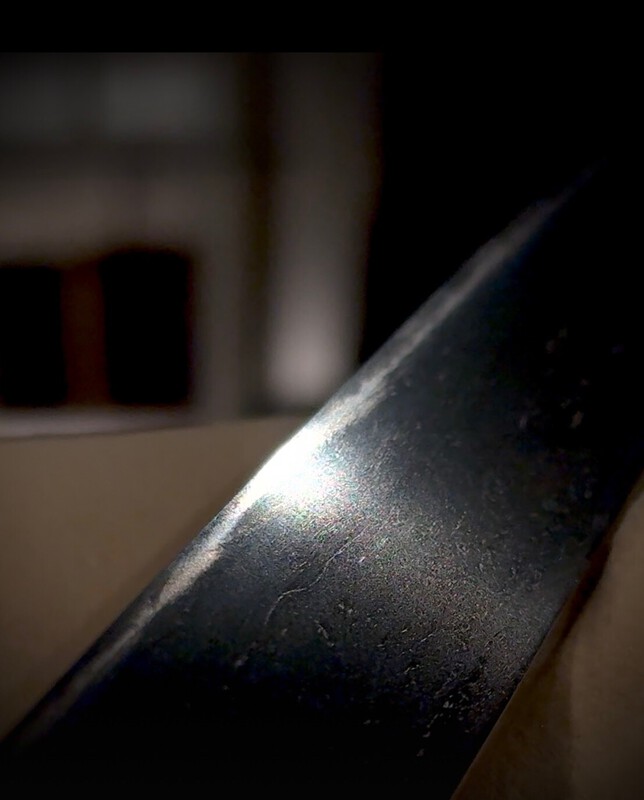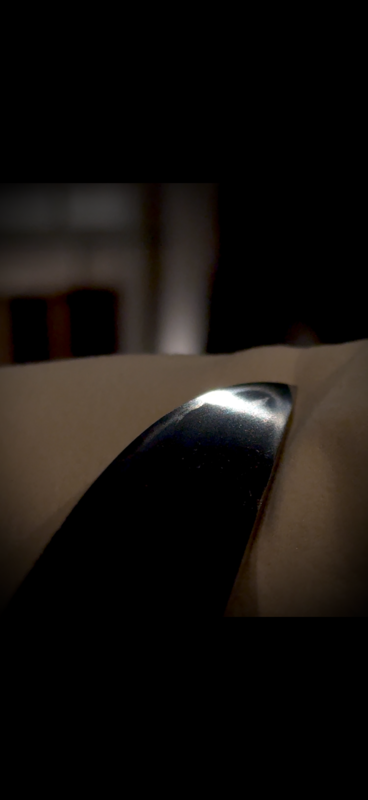Leaderboard
Popular Content
Showing content with the highest reputation since 07/21/2025 in all areas
-
A friend picked this up for me from Itoh-san at the San Fransisco Show. I originally saw it in Chicago in April and have been lusting after it ever since. I've previously purchased a piece by the 5th Master Shigenaga, but this is the first piece by an earlier Jingo smith that I have ever owned. Love the plate and the treatment of the iron. Was included in the 2013 NBTHK Kurogane no Hana exhibition, and has variously been attributed to the 2nd and 3rd Master. (Second by NBTHK and 3rd by Itoh-san.) Love the whole package and hope you all do as well. Hope you enjoy and thanks for looking!28 points
-
Not the place for it, but I am sure everyone joins me in wishing you well18 points
-
16 points
-
I remember a REAL TOGISHI who visited Melbourne Australia maybe 40 years ago now. He was a sponsored visitor by an art dealer who specialised in Japanese art. This man had never been out of Japan, had never traveled on an aeroplane in his life and didn't speak English. His father was a togishi and his grandfather also, the latter being taught by a Hon'ami of the day. Our art dealer did the tedious task of all the back-and-forth translating. We, the gaijin audience, had many revelations during his short stay. As he was viewing a sword one comment that stuck with me is "They should all be restored". I'm sure many of us would agree with this as even the humble kazuuchimono is a survivor of centuries aided and abetted by the Japanese themselves. Such a sword is a stark contrast to the higher tier swords, to be sure, but we would do well to remember the times and not our highfalutin opinions. The trouble is, of course, the time required to learn how to properly and correctly polish a sword and the consequent high cost of gaining a knowledge entry point. This all conspires to consign centuries-old swords as junk, derisively called 'crappers', even by me!! However, I do remember "the wide-eyed, child-like enthusiasm which led us all here in the first place" as I pored through my newly bought copy of John Yumoto's "The Samurai Sword" trying to understand my newly acquired first sword, a Sue Kotou katana in a rather nice and good condition Shinguntou koshirae. Its long since gone to support the purchase of undeniably better (even to my eye!) Tokuho swords. I still have that wide-eyed, child-like enthusiasm and more of this on the Board would be nicer than wild-eyed jousting. Surely we are better than this... BaZZa.15 points
-
A large number of documents & photos purpotedly owned by the Meiji-Taisho era smith Hayama Enshin were recently listed in Japan. Of considerable interest are the photos of test cutting by Enshin and what appears to be Nakayama Hakudo. The documents would no doubt prove rather enlightening to researchers, though the ambitious prices may halt such endeavors. Details on sword forging: https://auctions.yahoo.co.jp/jp/auction/d1196774017 Kiyomaro lineage: https://auctions.yahoo.co.jp/jp/auction/1196757911 Test cutting: https://auctions.yahoo.co.jp/jp/auction/v119678193613 points
-
These may be some life lessons. 水ハ苦クシテ求メヨ – Make the water bitter and drink it. 人ト人間ノ差 – The difference between a man and a human The first part of this sentence is unclear. 波…ハ世ノ 常デ……………… 任セテ雑魚ハ 歌ヒ雑魚ハ オドル サレド 誰ガ知ロウ 百尺下ノ 水ノ心ヲ 水ノ深サヲ However, I know that this sentence is the last part of a novel “Miyamoto Musashi” written by Yoshikawa Eiji. The whole sentence must be like this. 波騒は世の常である 波に任せて泳ぎ上手に 雑魚は歌い 雑魚は踊る けれど誰が知ろう 百尺下の水の心を水の深さを - Waves and noises are the norm in the world. Let the waves go, swim well, the small fish sing, and the small fish dance. But who knows the heart and the depth of the water a hundred feet below.13 points
-
Ray One or two comments from people from a certain country cannot equate to the entire country or be a representative sample. Indeed, you have contributed a lot to the study of swords in the U.K. and even here (eg, sharing all the scanned magazines and books!) and internationally (eg study sessions in Japan). You have trodden the tortuous path of collecting numerous swords from various sources (eg people could refer to your publication of your previous collection) and experienced first-hand numerous dealers and people in the community. You are trying to share some of your painful experiences so that others do not get burnt the way you did previously. Our To-Ken Society (which numbers 220 members by the way, not the 2-3 which are more vocal here) is grateful for what you have shared in terms of study material. The desire and ambition to educate is noble and yet the approach needs to be proportionate and appropriate. What might be pertinent for a certain member might not be suitable for another. We are all grown up here and can decide to heed advice or not. Unfortunately such is life - whether in politics, religion, business, hobbies etc. People sometimes listen/learn and sometimes choose to ignore what they are told. We as humans are all flawed like that. There are numerous valid tips you share above. In fact, I would say the advice you give is concordant with the straightforward “canon” in Japan. But emotion as well personal circumstances (and most importantly probably the lack of funds) might prevent people from following that archetype. The economic factor as well as impatience (covered elsewhere) often prevail. Please let us adhere to educating (or trying to). There are various lecturers and teachers here on this board (I know a few and they are prominent members of the board and the nihonto / armour / dealer community) and they can also attest: you can teach, explain etc but it is up to the individual student to wish to learn, follow recommendations etc.12 points
-
Howdy ya'll, If you ever need moderation assistance; such as with double posts, minor edits, or moving threads. Please feel free to tag me using @Scogg. When you start typing the @ symbol followed by my name, a dropdown should appear for you to select me. This sends me a direct notification and helps me respond more quickly. As long as it's aligned with the forum rules, I'm more than happy to assist. I check the forum regularly throughout the day, but tagging me ensures I can address your needs sooner. I'm here to help and want to do what I can to support the community and give Brian as much of a break as possible during his recovery. Feel free to reach out with any questions, All the best, -Sam12 points
-
So let's get to it First of all, my compliments to everyone who publicly presented their estimate and opinion I can only hope that no one was influenced by the file name for sugata (fixed in the meantime) Mea culpa It's easy to define what to focus on if one knows the answer Nevertheless, I'll try First of all, it's sugata Here is a composition of this blade with blades of the schools that appeared in the posts From the left, the blade in kantei/ Gotoba/ Ko-Ichimonji/ Yoshifusa/ Hatakeda Moriie ( Shodai ) All blades have approximately the same sugata and are ubu The monouchi area at the blade in kantei is losing sori (we can see the same at the Gotoba blade) That should point us to the Heian/very early Kamakura period Just like the Jifu utsuri in the photo of sugata The preserved funbari from the photo of sugata and from photo 2 should be evidence that the blade is ubu Nakago-jiri: very unusual for the school to which the blade is attributed Most likely the shape of the nakago-jiri changed shortly after the blade was made, as the patina shows no differences compared to the surrounding surface Also according to the hi in the nakago it is clear that the nakago originally had larger sori (widening of the groove where the nakago was straightened) The Jigane is not quite what we would expect from a Ko-Hoki It does not seem rustic at first glance and is rather a tight itame with mokume with a lot of ji-nie and chikei (I hope it is clearly visible in photo 5 and 6) Nioiguchi is hardened in nie (photo 1, 5, 10) with tobiyaki, which form a kind of nijuba (photo 4, 10 on the right) And finally the Boshi, which clearly tending with much hakikake to kaen ( does not occur in the Bizen school - I do not exclude that there is an exception ) Cleary see from the photo and also from the oshigata The blade is attributed to the Ko-Hoki school with a direct attribution to Yasutsuna You can find a gallery for this blade here https://eu.zonerama.com/Nihonto/Album/13418224 Congratulations to everyone who got Atari12 points
-
Hi, Priorities changed over the eras. Shortening during the turbulent Muromachi times were motivated by having the best, most functionally advanced sword by your side. It was life and death, no time for nonsense. It wasn’t seen as disrespect for Grandpa’s heirloom - the opposite in fact, it was given a new life to do what it was supposed to do: battlefield duty to protect grandpa’s family lineage. Oda Nobunaga was a serial O-suriage enjoyer and big collector. He wanted the option to use it. Only the curious dreams of the Uesugi Daimyo somehow led to a family-wide proscription on chopping up heirloom nakago. Later you see more refined approaches. Gakumei, Orikashi Mei, Kinzogan Mei, and so on and so forth. They are the fruits of a time where life and death battle royal wasn’t the only grand imperative. And again, it was seen as a sign of respect to the sword to be able to wear it in court. Remember that a Kinzogan Mei by the Ko-Hon’ami was seen as equivalent to a signed sword. You still have this attitude in Japan, where a Kochu Kinzogan or Origami is often said to be equivalent to a signed sword by old collectors. Gakumei were also susceptible to forgeries. You can always transplant a mei from a burned Norishige on your Ko-Uda, and make shenanigans. The alternative is the shenanigan-proof Orikashi mei. But It came later. it was also carried out outside of Hon’ami/Umetada shogunal institutions. And sometimes Mei were messed with for strategic reasons. At some point it became very risky to own a signed blade from a grandmaster for a small, or even large clan. There was always a bigger dog that would gently ask you to part way with the sword in a way you couldn’t refuse. Gakumei swords, swords with defaced mei (filed, chopped midway, half erased by the bohi extension…) - these were protected as they were considered less appropriate for gift giving. The Satake clan is noteworthy for having filed, defaced, extended bohi etc on all their family top swords. They probably got badly burned at some point and took drastic action. There are a lot of social circumstances surrounding nakago condition, and it is quite a fascinating topic. Personally I find Gakumei, Orikashi Mei, ko-Kinzogan, defaced Mei, and partial Mei swords wonderful. They tell the story of their times. Best, Hoshi11 points
-
Dear all. I have recently acquire a nice Heianjo Zogan tsuba. It is not a masterpiece but it is a nice one ansyway. The design is not the usual karakusa with trellis that. There are those bell shaped pieces that are somehow reminiscent of the koto string bridges. Any help in the identification of the theme is welcome. Best Regards Luca10 points
-
72 plate heavy Kabuto Edo period Thought to be Ichiguchi Myochin work Not sure if signed Would be interested in comments , the Tehen is a bit further back than normal and there is a noticeable bulge at the front. It's an usual number of plates. A period Mai Date. Many thanks to Nick Ricupero for selling this to me.10 points
-
For me, the journey started rather typical (for this day and age). I started out just reading and browsing the forum for a long time, trying to learn as much as I could. Then I came to the realization there's really no way to skip the book learning. So I bought Connoisseurs and read that several times. Next I picked up Markus' Japanese Sword Smith Index. I spent a lot of time looking at dealer offerings online and cross checking it with Connoisseurs and the Index. From the onset I had the Nanboku-cho period in mind because I love the sugata, and that particular and relatively short moment in history. I began looking at and reaeaching the top Soshu masters basically because of the reputation of being the pinnacle. I liked Kaneuji and Norishige the most, however getting close to the master's work at my set price range was not gojng to be very realistic. Kaneuji's history was particularly investing to me, so I started looking into Naoe Shizu as a sort of way to get Nanboku-cho Soshu at Mino prices. (Rember I'm a newbie). I liked the examples of Naoe Shizu I could find, and what really sold it was my picking up the Soshu Den Masterpieces book. The description there of Naoe Shizu being a quality blade that was sought after by actual warriors really did speak to me. Ive been through some s**t in my 15 years in law enforcement, and when I look at that work, it feels deadly but beautiful. I don't know if that's a good reason or not10 points
-
Sold a fairly average civilian mounted Gendaito that I adored because it had some really interesting activity. 10 Years later when my friend retired and sold his collection of knives, I bought it back. It's here with me again.10 points
-
I'm 77 next month, and started collecting in 1973. I stopped in 1981 and sold my collection as I had joined the West Australian Museum and did not feel I should collect. I started collecting again in 2008 when I left the museum - but this time only gendaito 1876 - 1945. I first became interested in Japan / Japanese swords as one uncle had spent 4 years 1945-1949 in the Occupation of Japan (in Hiroshima) and another uncle had brought back a sword from a surrender his Australian Army unit took in New Guinea (it is a gendaito of good quality but mumei - Type 98 mounts).. i was therefore always interested in Japan and studied Japanese history and language at Uni...and here I am, on a Japan oriented site - love it.10 points
-
Also remember that not everyone is a blade collector. Many are sword collectors ie the whole package together with untouched koshirae. Not everyone is an elitist blade hunter. If that is your “thing” - fine but don’t assume others even want to follow the same path. The sword collector most likely has a whole different set of objectives and tolerances which could easily mean accepting an unimportant blade or one in poor condition in return for some nice fittings. It has already been said above I’m sure but judging what others enjoy collecting based on your own views is irrelevant10 points
-
If you save $2000, ‘someone’ will tell you, “you should have waited and saved $5000.” If you save $5000, ‘someone’ will tell you, “you should have waited and saved $10,000.” If you save $10,000, ‘someone’ will tell you, “you should have waited and saved $20,000.” If you save $20,000, ‘someone’ will tell you, “you should have waited and saved $100,000.” Collect the way you want to collect. You do you. While graciously accepting advice is noble, there will always be people who love to tell you what to do with your money, what you should or shouldn’t buy, and why you messed up buying what you bought. That is always the easy part. Studying and knowing what you like, being happy with your purchases, and collecting for yourself vs others is a little harder. Is it more important that you are happy, or impressing others? Who are we buying these blades for?10 points
-
Here is the beginning layout out of the Aoe display at the SF show, prior to the actual hands-on viewing. There were 6 daito, 1 wakizashi, and 2 tanto. The sword committee seriously underestimated the attraction of the display. More than 100 people attended over 2 hours, 50 handouts disappeared early and so did other supplies. Kudos to the NBTHK-AB and the NCJSC.10 points
-
I don't think what Dan has is crap by any means. There are collectors for every level and there are some nice tsuba there. And to each their own. BUT...it is important to acknowledge the fact that is is always good advice to buy ONE very good item, than accumulate 20 average ones. We might choose not to go that route...but at least acknowledge it is good advice. I don't even follow it myself, as spending is spread over a great time, and if I save up a decent amount, it is better spent on bills and debt. Easier to pay out small amounts without missing it too much. BUT...I'll never recommend that as good advice. But ONE good item if you can. You'll learn a lot. I'll leave this with the ever-so-common event that I find myself in, buying knife collections here. I soooo often get someone calling me to sell me their husband's "extensive" knife collection. I go there expecting to find some good knives mixed in with average stuff. And to give the lady a decent amount of money. Only to regularly be met with a 100+ collection of gas station and Chinese flea market knives, none of them worth more than 5 bucks. I have to decline and explain. It's not a pretty sight. So yes, you may not plan on selling. But someone is going to have to, at some point. Luckily there is a market for antique tsuba...even average ones. But always keep this in mind. And even if you choose not to follow the advice, it is still best to pass it on to novices as best practice.10 points
-
It is interesting that the Tanobe-sensei sayagaki attributes the sword to just Shikkake in the lead-in (primary attribution) and then states Norinaga specifically within the body of the sayagaki. This is typically done when Tanobe-sensei writes a sayagaki where he is aligning with the judgement of the shinsa team, and then lower down he goes on to provide more specificity directly to an individual swordsmith. The sayagaki predates juyo. Likely the previous Tokubetsu Hozon kanteisho was also a school attribution to Shikkake, Tanobe-sensei expanded on this with the attribution within the body of the sayagaki, and then at the next level the juyo shinsa team also aligned with the Norinaga judgement.10 points
-
I am NOT going to allow this to be a discussion about the intention or person behind the advise here. Anyone who takes it there better gtfo out this thread, or take a break. I've had enough of people gunning for others, without adding zero to the study of Nihonto. Either you decide to take the advice (or parts of it) or you don't. In which case you ignore this thread and read others. Anyone posting personal attacks here WILL take a break. The advice is solid. Whether you choose to follow it or not, depends on how you collect. But since it's the same advice given in some major Nihonto books..are you arguing against that too? I don't care if you follow this advice or not. Myself?...I don't. I am ok where I collect, and know at what level I collect. But while I myself don't adhere to that advice, I am grown up enough to read it and appreciate where it comes from and not take it personally. If I can do that, you guys can too. So either politely discuss, or ignore this thread. I'm in too much pain to let this stuff add to my stress. Take the above seriously, I don't have time to babysit.9 points
-
Things have changed ……inevitably. I come from over 40 years ago. No internet, no computers, no mobile phones, very few books, no contact with Japan….starting from scratch armed with enthusiasm and a modest budget. I experienced the treasure hunts. Building contacts by word of mouth, adverts in papers followed by days spent responding, visiting the local weapons dealer to see if anything had turned up. Phone calls from strangers (some very strange) I’ve bought many swords from sheds, garages, country houses, local auctions (if Peter Yorke hadn’t found out about it) I’ve driven 400 miles to see a newly discovered dealer (Chris Shewen) but having arrived an hour early being told by his wife that he was asleep on the couch and I’d have to wait! Fellow enthusiasts driving down from Scotland because they had heard I was interested in Japanese swords. Can’t remember much about those encounters…they brought this rather potent liquid with them. A bundle of swords arriving in the post….one looked nice…turned out to be a Heian period blade in untouched Efu no Tachi mounts that made a bomb through Sothebys years later. Being brave and going to a Token Society meeting in London …..the less said the better. Going to see Mike Deann London (a dealer) ….did I want o sell them….no….then I really need to charge you for valuations… Virtually no swords in shirasaya. All in original koshirae from gunto to stunning Goto mounted daisho. Some rusty, some good but old school polish …..etc etc etc We learned things the hard way and slowly. That excitement has largely gone and will never return. IMO the hobby has become sterile….we were “sword collectors”, now it seems to be more “blade buyers” dependent more on your budget. Lots of shiny things in shirasaya with modern polish and papers. Ok if that’s your thing…fine. There are those that sneer at us early birds sadly….but they will never ever enjoy what we enjoyed.9 points
-
I have owned this sumptuous wakizashi twice and each time got tempted by bigger and bigger offers when I really didn’t need to. Last seen going through Sothebys I think. Truly beautiful and extremely high quality koshirae on a mint Kanefusa hirazukuri blade. By far the most luxuriously mounted sword I’ve ever owned. In perfect condition. I still kick myself. Anyone know where it is?9 points
-
9 points
-
We haven't had a kantei here in a while so let's try to have some fun I won't be posting any more details other than photos for now Each photo was chosen intentionally because it shows something that might help bring you closer to the period/school Since some of you have had the chance to see this blade in your hands, let's let the rest of you try to succeed in kantei9 points
-
9 points
-
I was inspired to post this article (from the January 1980 Issue of The Bujin) by the "with a little help from my friends" thread in the translation forum. I agree with the Kanezumi translation. I have found this useful over the years. With grateful thanks to Lovret Sensei. I don't think he would mind my posting it.9 points
-
9 points
-
I would like to quote from Tanobe Sensei's latest book on the Yamato tradition, where he elaborates a bit more on the Boston tantō that has bee mentioned: There was more than one generation Norinaga, and descendants of the first master continued to use this name until the Muromachi period. Period sword texts state that short signatures of the type “Yamato Norinaga saku” (大和則長作, “made by Norinaga from Yamato”) go back to the hand of the first generation, and such with longer signatures, containing the character Kunias in “Yamato no Kuni” (大和国, Yamato province) and prefixes like “Shikkake” and/or the honorary title Sakon no Jō (左近允) go back to the second generation, or possibly to later generations as well. The collection of the Museum of Fine Arts, Boston, contains a tantō (picture 1) that is depicted in the Kubikiri Asa’emon Tōken Oshigata (首斬り浅右衛門刀剣押形) and that is signed and dated: “Yamato Shikkake Norinaga yonjūhachi saku – Bunpō sannen tsuchinoto-hitsuji sangatsu tōka” (大和尻懸則長四十八作・文保三年己未三月十日) – “Made by Shikkake Norinaga from Yamato, age 48, on the tenth day of the third month Bunpō three (1319), year of the sheep.” In addition, there exists a tantō dated Ryakuō three (暦応, 1340), which is inscribed with the information that it was made when the smith was 69 years old. Accordingly, we can calculate Norinaga’s year of birth as Bun’ei nine (文永, 1272). When we follow the aforementioned period sources in terms of signature syntax, both tantō would be works of the second generation, meaning that the active period of the first generation obviously must be placed earlier than the two dates in question. When we examine the workmanship of a Jūyō-Bunkazai tachi signed “Yamato no Kuni Shikkake-jū Norinaga saku” (大和国尻懸住則長作, “Made by Norinaga resident of Shikkake in Yamato province”) (picture 2), and a tachi ranked Tokubetsu-Jūyō Tōken signed “Yamato Sakon no Jō Norinaga saku” (大和左近允則長作, “Made by Sakon no Jō Norinaga from Yamato”) (picture 3), and compare that to blades signed briefly “Yamato Norinaga saku,” the former do not date any later then the latter. In addition, the signature of both groups of works is fairly close, whereupon I tend to think that the period sources should be revised.9 points
-
Dear Denise, Yes, they are both Kamakura smiths. There is no explicit information on either the Sayagaki or the Setsumei that tilts towards one or the other. Now, let me explain something more important: I would not fret too much over Nidai or Shodai - as in, who made it, in the end. The scientific reason is that we cannot know, we do not have a time machine. We do not even know if NOR238 was really a different person from NOR237. Their period of activity is close, and the old paradigm of attributing stylistic and mei changes to subsequent generation is slowly being replaced a paradigm more consistent with Occam's razor: smith simply changes their styles and mei over time, especially those that have long period of activity and have intermediary pieces in terms of deki that allow for a continuity in interpretation to emerge from their corpus. This could very well be revised in the future. In your specific case, it would make no difference from a market perspective to me, having a blade signed in the NOR237 or NOR238 mei style, given an equally compelling deki. Both smiths are Tokuju capable, both smiths have Juyo Bunkazai blades with similar degrees of preservation in terms of mei. In terms of rarity, blades by NOR238 are even rarer than those by NOR237. And last but not least, to me at least, they are likely to be one and the same smith. I would be 100% focused on the deki when assessing the value of the object. Specifically, where it stands within the corpus of NOR237/NOR238, within the broader Yamato tradition, and in relation to other school founders. Best, Hoshi9 points
-
Jacques has previously made this disparaging comment about Tanobe sensei and I shall repeat the retort I made back then: “And the NBTHK Shinsa also gets paid for its appraisals, rejections and papers. All experts get paid, if their opinion is viewed by the public to be worth something. “ I think in the past I mentioned surgeons and private healthcare etc but the examples are numerous of when we pay to receive an expert opinion, specialist education, extra service etc. Moreover, I shall add: to Tanobe sensei his reputation and legacy are worth much more than a sayagaki written for a gaijin. I conjecture that Jacques probably has not factored that into his mental model. In fact, in my presence Tanobe sensei has examined various sayagaki under a magnifying glass to confirm whether they are his or not. So far, there have not been fakes that I am aware of but he occasionally reexamines his early sayagaki for some handwriting and other traits and might say “ah, this is one of my earliest sayagaki” etc. That clearly demonstrates that he cares about his sayagaki circulating around and he does not view them lightly. Also the language he uses is smartly worded, apart from giving insights or praise.9 points
-
This is such a huge subject that I am reluctant to get involved. Suffice it to say that the Mongols collected every last scrap of iron from their battlefields. Bushi would often leave money inside their armour to help pay for disposal and funerary rites, etc. if they were killed in battle. The problem in Japan was that battlefield weaponry might find its way into the hands of the peasantry. Feudal lords would designate merchants to clean up the battlefield, and to sort out what could be salvaged and what could be scrapped. Conversely, merchants would vie to get such contracts from the Daimyo. Cheaply-mended weapons were then sold on cheaply to the less wealthy Daimyo. Hideyoshi ordered huge national round-ups of weapons, in order to keep them from anyone who might be tempted to revolt. There were continued round-ups through Tokugawa times and on into Meiji. Essentially, Japan's governing bodies wished to maintain tight control over possible causes of unrest. Unlike in the west, battlefield clean-ups were the norm, and cleanliness and detailed bureaucracy still generally rule today.9 points
-
I think it is necessary to distinguish between the intellectual/academic aspect of studying and the financial realities of collecting. Consider Rayhan's list, which I will paraphrase here: Suriage and/or mumei is okay in pre-Muromachi work and not afterwards. Buy swords in good polish. Make sure any koshirae fits. Buy swords and not papers, but consider papered blades first. Upgrade swords when you can. These rules are mostly about the financial aspect of collecting: bluntly, it is easier to re-sell a blade that meets these criteria. So now let us consider the intellectual/academic aspect. Suriage is less than desirable because it does two things: it changes the sugata and we lose material (both overall and potentially a mei). But if you wanted the "best" ko-Bizen, and you had your pick of every blade in existence, and price was absolutely no object — you would probably pick an ubu zaimei example. So really, from an academic perspective, suriage and mumei are NOT okay, REGARDLESS of the period. We want ubu zaimei. But here practical reality kicks in. We do not have the pick of every blade, we do not have infinite budget, and we have to make some compromises. People should buy the things they can afford and that they like. If someone wants to have a collection of kazu-uchimono, there is nothing intrinsically wrong with that. The problem is when there is a misunderstanding of the commercial realities of the market or a gap in scholarship. If someone thinks a kazu-uchimono is on par from an academic/historical perspective with a Gojo Kanenaga or Tomonari or whatnot, I think this is a failing of their education. But that doesn't mean their kazu-uchimono collection doesn't have a story to tell. You do not have to spend a lot of money to have developed meaningful understanding. I have more than a few things that I bought because I liked them, not because they were "important." But that doesn't mean that I can't understand the nature of what "important" means and why something the example I own is not going to command the highest prices in the market.8 points
-
8 points
-
I have every confidence in Sam's decisions. He made the right choice. I opened it again for people to have their last say so that no-one blames Sam. Then I can lock it again like I am going to do to this one, and then people can blame me. Enough of this bullshit.8 points
-
8 points
-
寺島博愛 – Terashima Hakuai The 3rd kanji is not 傳 (den), but 博 (haku). I guess that he might be this Terashima Hakuai. Taisho 13th year, Joined Nippon Yusen. Showa 18th year, Captain Showa 20th year, Manager of Marine Department Showa 23rd year, Chief Manager of Marine Department Showa 27th year, Associate Director Showa 29th year, Counselor He is the author of 海難の処置と処理 (Measures and management of marine accidents) published in 1960.8 points
-
8 points
-
Normally I do not think about blades that are gone, but now that you bring up the subject, there are several. Not actually sure now why I sold them. One was a papered Sue So-Shu tanto in red koshirae with matching shinchu fittings. Every yellow-green part, including the kozuka and wari-kogai was original to the piece, and each part bore the same Mon. I sold it at auction more out of curiosity to see what it would fetch, but it went for almost exactly what I bought it for, and I think it must have then gone over to China. All I gained from the liaison was the sweet memory. Would I ever find something similar again? Now you've got me wishing again that I still had it!8 points
-
Ok let us ignore the Hanwei stuff/ China replica as they have no bearing here. Instead we will look at O-Kissaki to start. Most collectors new and old have some love for O-Kissaki but on that mountain there are Kings (none in your budget) and there are outliers that can be surprising. When looking at O-Kissaki you will have 3 eras to observe. We know O-Kissaki started in the Nanbokucho era and some can be found in the early Muromachi period then going into the ShinShinto eras and finally you get them in Modern times. Some of the Kings of O-Kissaki are: Nanbokucho (Koto) Chogi, Shizu, Naoe Shizu, Nobukuni, Kencho, Hasabe, Motoshige, Kanemitsu, Norishige (period specific, he later changed to Heian Sugata), Kunimitsu, etc, etc but to help you see them you can see these links (not for buying but observing, I am using online links as most people do not buy books anymore, why? no idea.) * Note that in the downloads section in the NMB you will find a lot of material also. https://markussesko.com/articles/ https://www.sho-shin.com/ https://www.nihonto-museum.com/collection/masamune-no-jittetsu https://www.nihonto-museum.com/collection/sadamune-no-santetsu From the Muromachi you will see things like this: https://www.nipponto.co.jp/swords2/KT219471.htm (not exactly O-Kissaki but still a powerful Sugata. I have seen this one in hand in Osaka and I think the day will come when it walks into TJ, but that is another thread). Going into the ShinShinto you will see the kings of O-Kissaki are Satsuma, Kiyomaro and his school https://www.nihonto-museum.com/collection/satsuma-province-swordsmiths https://taiseido.biz/products/detail/pg93.html Those are just a few examples. But you have a budget so scouring through what little liks I have in your budget we can find a few items like so (Japan only as you want to buy there) I have taken liberty to go from 400K to 800K JPY. https://www.tsuruginoya.com/items/a00646.html https://www.tsuruginoya.com/items/a00659.html (Naginata Naoshi, not O-Kissaki but might still get the heart pumping. Note that Naginata Naoshi do not retain value very well and is a have a specific type of collector that appreciates them) https://world-seiyudo.com/product/ska-120124/ (will paper for sure) https://www.sanmei.com/contents/media/S72306_S1304_PUP_E.html (will not paper because the smith is still living, I think?) https://www.samurai-nippon.net/smp/item/P-988.html 9not magnificent O-Kissaki but a nice Kissaki in terms of shape, condition is another story) https://www.samurai-nippon.net/smp/item/P-811.html 9more of an Iaido sword, smith is still alive) https://www.samurai-nippon.net/smp/item/P-911.html (Nobukuni has archetypical sword styles and this isn't really one of them but for the sugata it is ok. Condition is polished down so you might be buying a sugata and shape you like but very little to learn from) https://www.samurai-nippon.net/smp/item/P-846.html (strange one but papered. Condition issues as polished down and Muromachi) https://www.samurai-nippon.net/smp/item/P-878.html (not O-Kissaki but nice Sugata and could be papered in the future with Koshirae it would be a nice starter) https://www.samurai-nippon.net/smp/item/P-467.html (Issues on the Nakago, Massive sword, unkown school but has papers, needs a polish to bring out the disco) https://www.nipponto.co.jp/swords5/NT329440.htm (will paper in the future, I think the smith is still alive) https://www.nipponto.co.jp/swords11/NT334358.htm (will paper, to get masame right on a sword this long is a feat on its own, but needs a polish maybe) https://www.touken-matsumoto.jp/en/product/ichiran/tachi_and_katana These are a few suggestions based on your O-Kissaki comment but if you want to narrow it further then Era, Hamon, Jigane, etc needs to come into play. There is no shame in buying a ShinShinto to Modern sword if forged well and has elements of learning just for the Hamon, Jigane, hataraki and such. If you want something more in the future you will have no issues selling them (especially if papered) and then going forward. No you do not need to lose money but be smart about it. Now in Unicorn teritory you will find swords at high prices but keep in mind that Unicorns have specific buyers and you have to hold it for a long time as oposed to fater moving lower priced items. Remember that when you really know what you want, gravitating to a Unicorn and having just the one sword collection is an achievement on its own. You dont have to have Osaka castles collection to have a great sword collection, you just need that one. And no, do not just buy what you like, you will like a lot of stuff at this stage, the point is to progress. We all had lots of lovers but in general we are working through a process of elimination to find the one. Before you go gallivanting into dealers in Japan please learn the proper etiquette before hand of handelling the swords as mistakes here will get you thrown out and the community is so small that word spreds. You won't find anything after that. Also make appointments and send them the links to the swords you want to see. Buy from the right dealers and you will build a great relationship. Buy from the sharks and you will be used and abused all week. Caution: Aoi Art swords: This dealer is very approachable and it is hit and miss with them so you really need to know what you are looking at and for. https://www.aoijapan.com/img/sword/2025/25235-2.jpg https://www.aoijapan.com/wakizashi-sakuyo-bakkashi-hosokawa-masamori-kao/ (One of my favorite ShinShinto smiths) Others you might like: https://www.toukenkomachi.com/index_en_tachi&katana_A060224.html https://www.toukenkomachi.com/index_en_tachi&katana_A101024.html https://www.e-sword.jp/katana/2510-1069.htm (The interesting thing with swords like this is they will paper if the Mei is intact and the smith is no longer alive. Then you really have a full parcel) https://www.samurai-nippon.net/smp/item/P-852.html (condition issues) When you narrow stuff down we can go into pro and con of each, at this price range there are always cons and it is an accepted known.8 points
-
Dave, Time is your friend. You don’t have to rush this: your sword money will still be in the bank when you know enough to make a more informed decision.8 points
-
I am going to say rather than trying to cram for this like a test, you could hire an expert for the day. There are ex-pats (experts) who are currently living in Japan that specialize in this field. Someone like Paul Martin or better yet Robert Hughes who is on this board could I am sure act as a guide for a day at a small fee, take you to sword shops, help you negotiate deals, help you recognize quality and later handle export procedures. This way you can travel with confidence and avoid a feeling of being lost or unable to communicate thus ensuring a happier experience... -t8 points
-
8 points
-
8 points
-
8 points
-
Offering a high quality gendaito by the famous swordsmith Takahashi Yoshimune. He was the brother the Gassan smith Takahashi Sadatsugu: the first Living National Treasure swordsmith. This blade is forged in an itame jihada with some flowing areas. The hamon is generally choji / juka-choji in the Bizen-den as it typical of his work. The blade is signed Minamoto Yoshimune and has an invocation of Hachiman Daibosatsu inscribed on the nakago as well. There is much activity, as shown in the photos below. The blade is in shirasaya with a sayagaki (unsigned). Bio per Markus Sesko below. YOSHIMUNE (義宗), Shōwa (昭和, 1926-1989), Ōsaka – “Hachiman-Daibosatsu Minamoto Yoshimune saku” (八幡大菩薩源義宗作), “Minamoto Yoshimune” (源義宗), “Takahashi Yoshimune” (高橋義宗), real name Takahashi Yoshimune (高橋義宗), he was the younger brother of Takahashi Sadatsugu (高橋貞次) and came originally from Ehime Prefecture, from 1913 he studied under Yokoyama Sukesada (横山祐定) and learned in 1918 also from Henmi Yoshitaka (逸見義隆) and even later also from Enju Kunitoshi (延寿国歳), he died in 1946, his speciality was a gunome-chōji in the Bizen tradition, he also worked as rikugun-jumei-tōshō, shinpin no retsu (Akihide), Special Honor Seat at the 6th Shinsaku Nihontō Denrankai (新作日本刀展覧会, 1941) $4,750 + shipping8 points
-
Dennis, I agree with those telling you not to get caught up in obsessing over generational differences. I often need to heed my own advice, but, as Hoshi has pointed out, it’s pointless to stress about such things. With mumei blades it’s easy to worry about the strength of the attribution or the subtle differences with signed pieces. And with zaimei works you can easily get lost wondering about which generation forged it. Case in point: Pictures below are of a zaimei Shikkake Norinaga tanto I recently purchased. It has Hozon papers, which in and of itself doesn’t necessarily mean much, and it was listed as Kodai Norinaga. Tanobe’s sayagaki gives the time of manufacture from the end of the Nanbokucho to Oei. Once upon a time it might have been attributed to the work of the Nidai or the Sandai. Indeed, the dealer who originally listed the sword said it was the work of the Nidai. But as recent scholarship started questioning the generations’ work periods, Tanobe and the NBTHK started assigning blades to likely time of manufacture, rather than generations of smiths. This is especially true when it’s not a slam dunk for a particular generation. You see this in Nobukuni and Hasebe attributions as well these days. I bought this piece is for serval reasons, including: 1) I am a tanto collector and zaimei Yamato tanto are not common, even Norinaga, which according to Jussi’s research, has 14 zaimei tanto (more than most Yamato smiths but still not many,) seven of which are Juyo from different era. 2) The sugata is lovely to my eye and the length at 29.2cm is sweet. 3) While there are some coarse areas on the ji from many polishes, the activity in the hamon is still wonderful and better than most Kodai blades I have seen, on a par with many of the Juyo examples. 4) It was relatively inexpensive with koshirae, always a nice extra. The key to all of this is that I liked the work. It’s better than most I have seen for sale over the years, and the price was right. And I got to study a new smith and school from a fascinating period of Japanese history. That is ultimately why most of us are in the hobby. The market does what the market does, and smiths fall in and out of favor. All that matters is that you like it. I think yours fits within the work of the Shodai, but even it is by another hand, it’s still lovely.8 points
-
I was pointed out to this thread to comment. As written in the preface to my publication: "Point (3) lists the handed-down artistic period where this date has to be taken with a grain of salt. Some dates are based on extant dated signatures and are more or less accurate, but most of them were transmitted again and again over the centuries with the initial listings often simply based on hearsay." What I am trying to say is that all of that is piling on and piling on atop of surviving period sources. There is re-assessment necessary on all levels, no exception. And that is where we are right now.8 points
-
Your advice is very solid Rayhan, and I think it is wise for all of us to think about our decisions. Especially new people can buy something without thinking too much and if they would have waited for few months might be able to get an item that they enjoy much more. There was actually a recent thread where several of you guys were giving very solid info and recommendations to a new member. I do think that buying items is important to enjoy the collecting aspect of the hobby. I have fallen more into researcher category as I do enjoy that part immensely but I understand for most people it is the collecting that makes the hobby for them. So for collecting I think that buying & selling items is a major part of the enjoyment of this hobby. While it might not be optimal in terms of gathering funds for larger purchase, I would think it would be more enjoyable for many to have some items to enjoy while they save up for major purchase. Sure the money could be better invested in something else for 5 years for example and then used for larger purchase and it would be perfectly ok to do that too. For the low level items I think it is decently safe to get roughly the same investment back when reselling. Of course the initial investment need to be taken into consideration but if you have modern NBTHK papered item it will always sell for decent price outside Japan. The higher up you go in price the more variable it will get and people need to be cautious. For 2000€ sword losing 50% is only losing 1000€ or you could in lucky case get 150% and score 1000€ in your pocket in resale. Now think about 40,000€ sword and losing 50% is losing 20,000€. Of course you could in extremely lucky case sell it for profit but I think for a private person it will be more difficult to make profit on expensive swords, that is high end dealer playground. I can only imagine it would be extremely stressful to think about so large (money amount) fluctuations in price. As for personal collecting to maybe as a slight shock I don't care at all about the smiths/schools or quality... I don't actually want Masamune, Nagamitsu, Rai Kunitoshi etc. Currently even condition is bit irrelevant for me if I like the shape of the blade which for me is about the only thing that really matters. Even with unlimited budget my dream of personal collection would be 1. Muromachi period ōdachi 2. Muromachi period ō-naginata/nagamaki 3. Nanbokuchō period ōdachi 4. Nanbokuchō period ō-naginata/nagamaki Would it be completely irrational to choose a huge sword with condition issues and no papers over a pristine Tokubetsu Jūyō sword for example, of course. I know myself that I would enjoy that flawed ōdachi more than a very high level sword in my personal collection.7 points
-
You may also want to look into this practice: https://en.wikipedia.org/wiki/Ochimusha7 points
This leaderboard is set to Johannesburg/GMT+02:00


